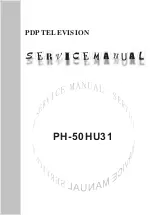
Service Modes, Error Codes, and Fault Finding
5.
observers are only used during start-up, they are described in
the start-up flow in detail (see section “
”).
5.8
Fault Finding and Repair Tips
Read also section “
,
5.8.1
Ambilight
Due to the aging process on the LED’s fitted on the Ambilight
module, there can be a difference in the colour and/or light
output of the spare ambilight modules in comparison with the
originals ones contained in the TV set. Via SAM => alignments
=> ambilight, the spare module can be fine-tuned.
Other possibility: the original values can also be recovered via
SAM, Upload to USB => alignments. Now the original settings
are on the USB stick and can be reloaded into another SSB
(NVM).
5.8.2
CSM
When CSM is activated and there is a USB stick connected to
the TV, the software will dump the complete CSM content to the
USB stick. The file (Csm.txt) will be saved in the root of the USB
stick. If this mechanism works it can be concluded that a large
part of the operating system is already working (MIPS, USB...)
5.8.3
DC/DC Converter
Description
Input power for the TV platform comes from the main power
supply that de3V3STANDBY (pin 1 of connector 1M95)
and +12V (pins 5,6 of the same connector). +3V3STANDBY
(3.3V nominal) is the permanent voltage, supplying the standby
microprocessor inside the Fusion chip while +12V is started by
the STANDBY signal (connector 1M95, pin 2) when going from
high to low. +12V is split in three branches via fuses 1UA0
(+12Va), 1UA1 (+12Vb) and 1UP1(+12-DVBS):
•
+12Va serves as input voltage for the switching voltage
regulators that d1V1-FD and +1V5.
•
+12Vb is used as input voltage for the switching voltage
regulators that d3V3 and +5V.
•
+12V-DVBS (if DVB-S functionality is present) goes to 12V
to +1V0-DVBS and 12V to +V-LNB switching regulators.
The on board power supply consists of 4 switching voltage
regulators (6 in case of DVB-S version), 6 linear voltage
regulators (7 in case of DVB-S version) one power switch
deli3V3AL for Ambilight driver boards and an over-
current protection for 12V (AMBI-POWER) Ambilight boards.
All switching voltage regulators have 12V input voltage and
deliver:
•
+1V0-DVBS core supply voltage for DVB-S2 demodulator
(1.02V nominal), stabilized close to the point of load by
means of SENSE+1V0-DVBS signal.
•
+1V1-FD Fusion main core supply voltage (0.95V...1.2V -
depending on DVS1 signal), stabilized close to the point of
load by means of SENSE+1V1-FD signal.
•
+1V5 supply voltage (1.53V nominal), for the DDR3
memories and DDR3 interface of the Fusion chip.
•
+3V3 supply voltage (3.37V nominal): overall 3.3V for on
board IC’s and for WiFi module, also used as input voltage
for linear voltage regulators deli1V1-FA, +1V2-FA
and +2V5.
•
+5V (5.15V nominal) for USB, WiFi, Conditional Access
Module and via linear voltage regulators, the DVB-T and
DVB-S tuner supplies.
•
+V-LNB (13V or 18V) supply for outdoor satellite reception
equipment.
The linear voltage regulators are providing:
•
+1V1-FA supply voltage (1.10V nominal, from +3V3) for
low power analog (PLL) blocks inside Fusion chip.
•
+1V2-MIPS supply voltage (1.05...1.3V depending on
DVS2 signal, input voltage: +1V5) for Fusion auxiliary core.
•
+1V2-FE supply voltage (1.20V nominal, from +1V5) for
HDMI multiplexer and (if present) DVB-T2 demodulator IC
device.
•
+1V2-FA supply voltage (1.20V nominal, from +3V3) for
higher power analog Fusion internal blocks (mainly video
ADC’s).
•
+2V5 supply voltage (2.5V nominal, from +3V3) for LVDS
(or Vby1) interface and various other internal blocks of
Fusion.
•
+3V3 supply voltages (3.3V nominal, from +5V) for RF
tuners, separate linear regulator per tuner.
Supply vo1V1-FD, +1V5 and +1V2-MIPS are started
immediately when +12V rises above the 5V level. The rest of
the supply voltages (+5V, +3V3, +2V5, +1V2-FA and +1V1-FA
are turned on by signal DETECT12V when becomes high. The
tuners are supplied from their respective linear voltage
regulators when +5V 1V0-DVBS is started almost at the
same time, when +2V5-DVBS (derived from +3V3-DVBS via
the equivalent diode 7RC2) rises.
DETECT12V becomes high when +12V rises above 10V and
stays above 9.5V (0.5V hysteresis).
+3V3AL will become available when enabled via software
(signal ENABLE-3V3-AMBI high).In case of TV sets having
Ambilight consumption from 12V + higher than 1A, the
electronic protection circuit (7UAC and surrounding
components) is used instead of fuse 1UA2. AMBI-POWER
should be available shortly (100 ms) after +12V starts if there
is no load on it. The over-current trigger level is around 4.1A.
Once triggered, it can be reset by removing the shortcircuit
cause and keeping it under no load condition for about 100 ms.
+V-LNB value is determined via software: around 13V for
vertical polarized satellite channels and around 18V for the
horizontal ones. Maximum current is limited in both cases to
400mA
Debugging
The best way to find a failure in the DC/DC converters is to
check their start-up sequence at power “on”, presuming that
the external supply is operational. Take the STANDBY signal
"high"-to-"low" transition as trigger reference and check the
power start-up sequence as described above.
Tips
•
Behaviour comparison with a working Fusion platform can
be a fast way to locate failures.
•
Check first the integrity of fuses 1UA0, 1UA1 and (if
present) 1UA2 and 1UP1.
•
If a fuse is found interrupted: check the resp12Va
(or +12Vb or +12V-DVBS) short circuit with all of the
derived supply voltages, for example: a +12Va ->+1V5
short circuit will probably be caused by a defective 7UB5
integrated circuit.
•
Switching frequency should be around 400KHz for 12V to
+V-LNB switching voltage regulator, 500KHz for +12V to
+1V1-FD and 600KHz...700KHz for the others.
•
When a short circuit to GND is found on one of the supply
voltage delivered by a switching voltage regulator, then try
first removing the power coil(s) from the output filter of the
converter, this to point the location of the short circuit (at
converter side or at load side).
5.8.4
Power Supply Unit
For fault finding tips, refer to section
















































